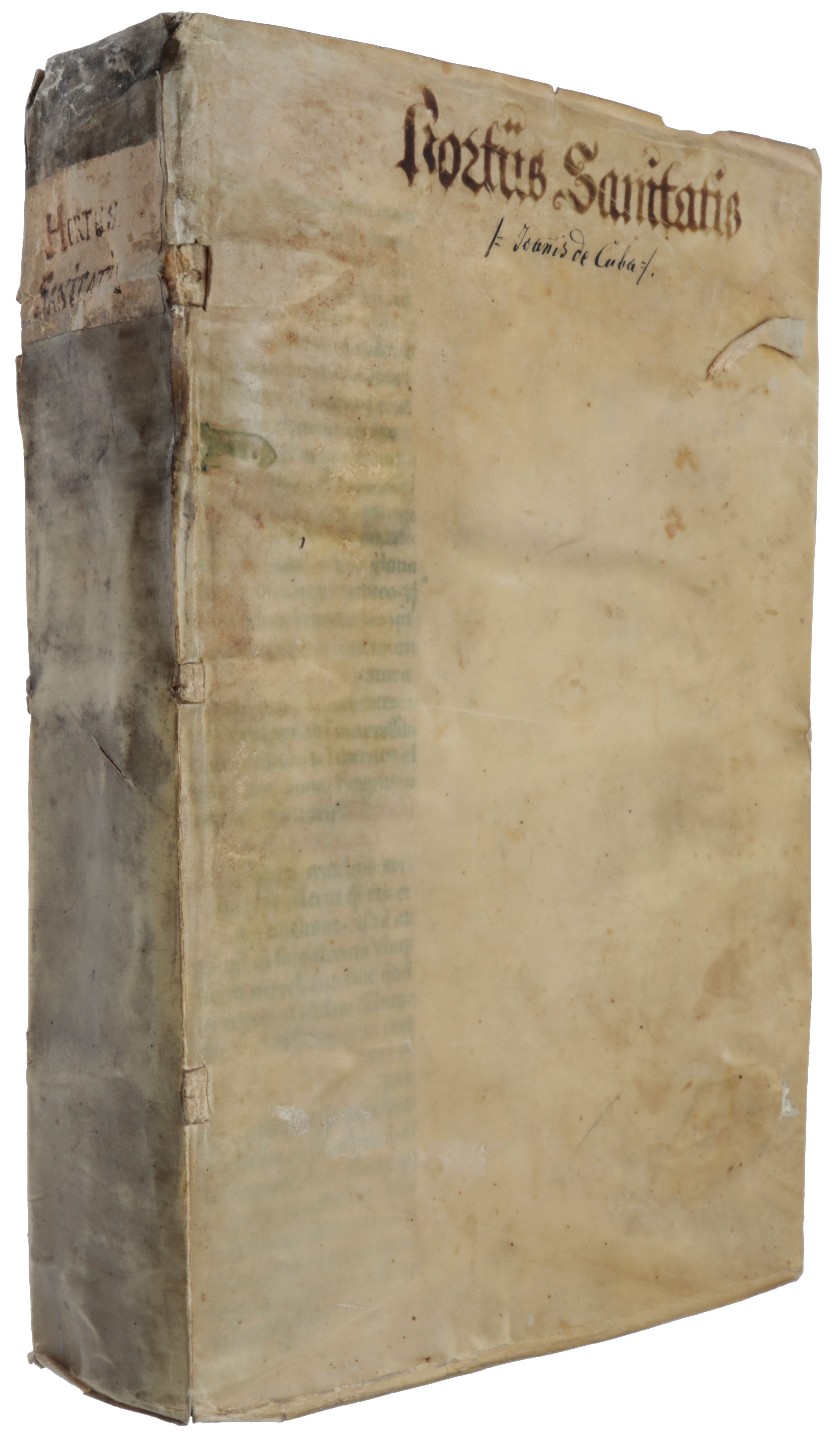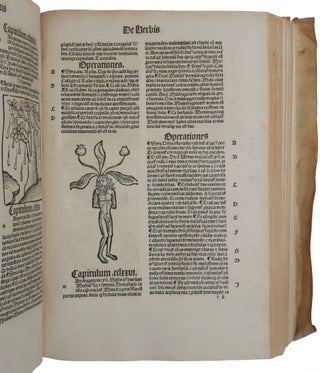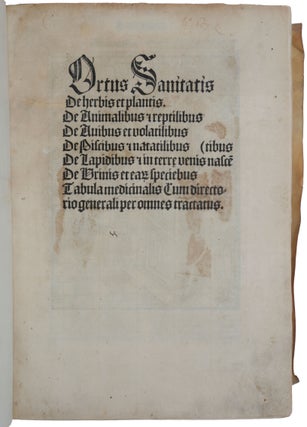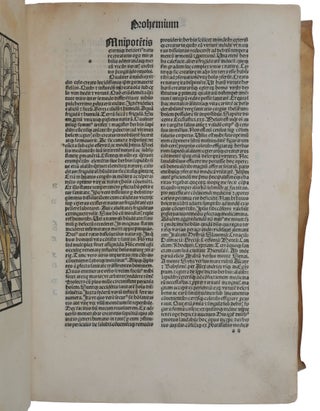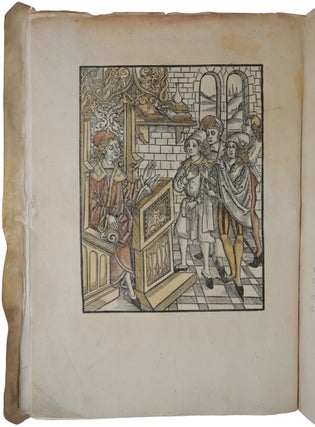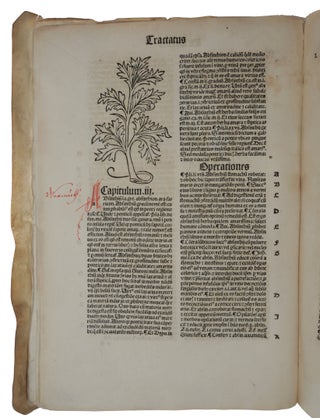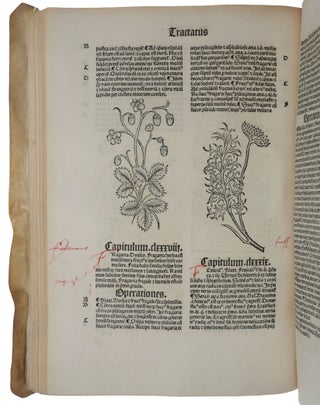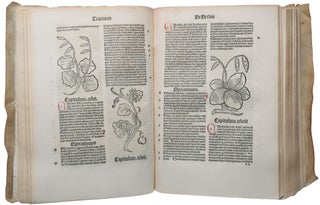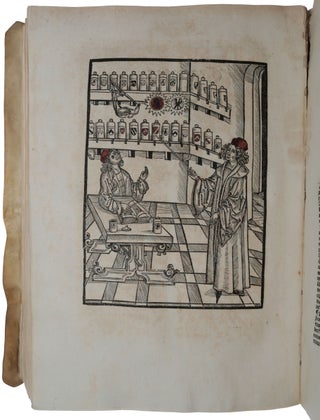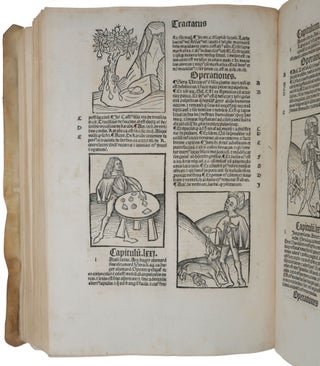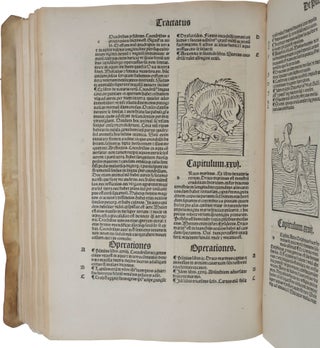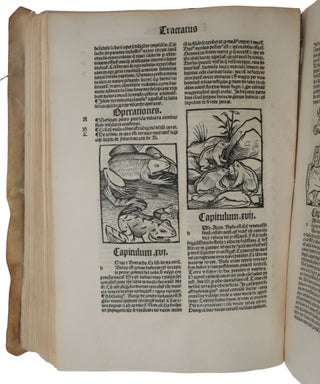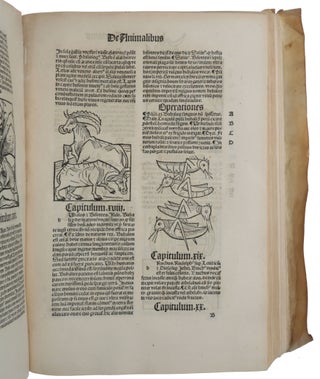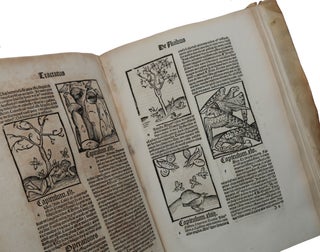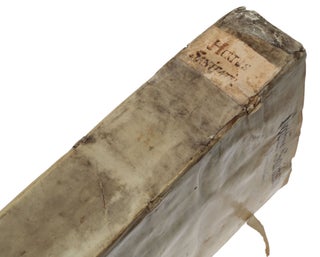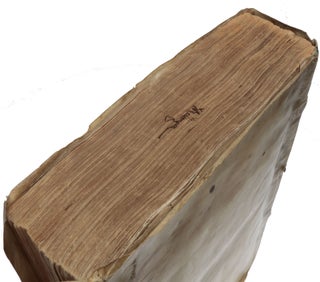Hortus Sanitatis. De Herbis et Plantis. De Animalibus et Reptilibus. De Avibus et volatilibus. De Piscibus et Natatilibus, De Lapidibus et in Terre Venis Nasce(n) tibus. De urinis et earum speciebus. Tabula medicinalis. Cum directorio Generali per pmnes Tractatus.
Strassburg: Johann Prüss, not after 21 October, 1497. Second (first Strasbourg) Latin edition, very rare, of the most extensive 15th-century work on natural history and medicine, first published by Meydenbach in Mainz in 1491, and compiled by the German doctor and herbalist Johannes de Cuba or Johannes von Kaub (fl. 1484-1503). It was the prototype for all subsequent editions. Due to its date of printing, it is the last major medical work to cover medicines from the Old World only. The Hortus sanitatis, meaning ‘Garden of Health’, provides information on the medicinal use of plants and animals both real and mythical. It is partly based on the Gart de gesundheit, published in 1485, which is sometimes attributed to Johann von Cube, and was originally printed by Peter Schöffer at Mainz in 1485. However, it should be regarded as a separate work, as it covers nearly 100 more medicinal plants than the Gart der gesundheit and also includes extensive sections on animals, birds, fish and minerals. The Hortus Sanitatis is divided into 6 parts: De Herbis, with 530 chapters on herbs; De Animalibus, with 164 chapters on land animals (Chapter 1: De homo); De Avibus, with 122 chapters on birds and other airworthy animals; De Piscibus, with 106 chapters on aquatic animals; De Lapidibus, with 144 chapters on semi-precious stones, ores and minerals; and the sixth constituting an essay on uroscopy, the medieval art of performing diagnoses through examination of a patient’s urine. It is printed in Gothic characters in two columns of 55 lines and includes abundant illustrations copied from the 1491 edition, consisting of over 1000 woodcuts the width of a column, several of which are repeated, depicting hundreds of plants, mammals, birds, insects, fish, monsters and other fabulous creatures. In its many editions and translations, the Hortus Sanitatis was the most popular and influential herbal of its time, and served as an encyclopaedia of the plant, animal, and mineral kingdoms and the medical applications of their products. ABPC/RBH list only two complete copies. “It was not until the Early Renaissance that Man discovered Nature in all its richness and plunged into investigating it. This gave rise to new truly empirical and experimental methods of studies, being in sharp contrast with the traditional scholastic approach and a mystic understanding of the world. In his thirst for knowledge Man treated Nature not as a passive object of contemplations but as an unusually rich source which, once understood and investigated, would reveal all of its wealth. Mysteries of Nature and their discovery got to the forefront of scientific research, which was also engaged in rearranging and revising the earlier evidence based on classical and mediaeval sources. This period is particularly fascinating as the time of settling accounts with the earlier experience and discovering new territories and tools of scientific development such as invention of printing … “Folk medical knowledge was a general source of information passed on from generation to generation. Its dissemination was made easier as herbals appeared at that time. Those were the first medical and botanical printed books of encyclopaedic nature. They could hardly be called scientific in the present-day sense of the word since the concepts of the Middle Ages and Early Renaissance were rather aimed at rearranging and popularizing what had already been known. Nevertheless, such books were signs of the times and an important step on the way to science … “Herbarium by Apuleius Placotonicus (or pseudo-Placotonicus) is the earliest printed herbal, published in Rome most likely in 1481. In the foreword the author mentions the Monte-Cassino manuscript over a thousand years old as a source-book for his Herbarium. This treatise combines medicinal formulae with description of herbs. Soon afterwards three printed books came out in Mainz that were to have a strong influence on the future of pharmacy. Those were the Latin Herbarius (1484), the German Herbarius (1485) and Ortus (Hortus) Sanitatis (1491). The first two of them must have been based on earlier manuscripts though the evidence of such borrowings can be found only when these herbals are compared with the texts by Apuleius or with the ancient Greek and Roman originals” (Kuznicka, pp. 255-257). “The first of these is the Latin Herbarius of 1484, which gives pictures and descriptions of 150 plants found in Germany, both native and cultivated … Schöffer’s German Herbarius [i.e., the Gart de gesundheit], one of the first scientific books printed in a vernacular language, appeared in 1485. It is larger than its Latin brother, with nearly 400 plants illustrated, and its text is not related to that of the earlier Herbarius, being compiled, according to the introduction, by an anonymous amateur botanist, with the advice of Johann von Cube” (Raphael, p. 249). “The third of the fundamental botanical works, produced at Mainz towards the close of the fifteenth century, was the Hortus, or as it is more commonly called Ortus Sanitatis, printed by Jacob Meydenbach in 1491. It is in part a modified Latin translation of the German Herbarius, but it is not merely this, for it contains treatises on animals, birds, fishes and stones, which are almost unrepresented in the Herbarius. Nearly one-third of the figures of herbs are new. The rest are copied on a reduced scale from the German Herbarius … “The Ortus Sanitatis is very rich in pictures. The first edition opens with a full-page woodcut, modified from that at the beginning of the German Herbarius, and representing a group of figures, who appear to be engaged in discussing some medical or botanical problem. Before the treatise on Animals, there is another large engraving of three figures with a number of beasts at their feet, and before that on Birds, there is a lively picture with an architectural background, showing a scene which swarms with innumerable birds of all kinds, whose peculiarities are apparently being discussed by two savants in the foreground. The treatise on Fishes begins with a landscape with water, enlivened by shipping. There are two figures in the foreground, and in the water, fishes, crabs and mythical monsters such as mermen, are seen disporting themselves. Before the treatise on Stones, there is a very spirited scene representing a number of figures in a jeweller's shop, and two large woodcuts of doctors and their patients illustrate the medical portion with which the book concludes. “The treatise on Plants is considerably modified from the German Herbarius, and the virtues of the herbs described are dealt with at greater length. The Herbarium of Apuleius Platonicus is more than once quoted, though not by name. A number of new illustrations are added, some of which are highly imaginative. The Tree of Life and the Tree of Knowledge are dealt with amongst other botanical objects, a woman-headed serpent being introduced in the first case, and Adam and Eve in the second. There is a beautiful description of the virtues of the Tree of Life, in which we read that he who should eat of the fruit ‘should be clothed with blessed immortality, and should not be fatigued with infirmity, or anxiety, or lassitude, or weariness of trouble.’ The engraving which is named Narcissus has diminutive figures emerging from the flowers, like a transformation scene at a pantomime! It is probably, however, intended to represent the conversion of the beautiful youth, Narcissus, into a flower. Apart from these mythological subjects, there are a number of very curious engravings. A tree called ‘Bausor,’ for instance, which was believed to exhale a narcotic poison, like the fabulous Upas tree, has two men lying beneath its shade, apparently in the sleep of death. “Among the herbs, substances such as starch, vinegar, cheese, soap, etc., are included, and as these do not lend themselves to direct representation, they become the excuse for a delightful set of genre pictures. ‘Wine’ is illustrated by a man gazing at a glass; ‘Bread,’ by a housewife with loaves on the table before her; ‘Water,’ by a fountain; ‘Honey,’ by a boy who seems to be extracting it from the comb; and ‘Milk,’ by a woman milking a cow. The picture which appears under the heading of Amber shows great ingenuity. The writer points out that this substance, according to some authors, is the fruit or gum of a tree growing by the sea, while according to others it is produced by a fish or by sea foam. In order to represent all these possibilities, the figure shows the sea, indicated in a conventional fashion, with a tree growing out of it, and a fish swimming in it. The writer of the Ortus Sanitatis, on the other hand, holds the opinion that Amber is generated under the sea, after the manner of the Fungi which arise on land. “The treatises on animals and fishes are full of pictures of mythical creatures, such as a unicorn being caressed by a lady as though it were a little dog, recalling the ‘Lady and Unicorn’ tapestry in the Musee Cluny – a fight between a man and hydras – the phoenix in the flames – and a harpy with its claws in a man’s body. Other monsters which are figured include a dragon, the Basilisk, Pegasus, and a bird with a long neck which is tied in an ornamental knot. “Later Latin editions of the Ortus Sanitatis were printed in Germany and Italy, and translations were also popular. The part of the book dealing with animals and stones was produced in German under the name of Gart der Gesuntheit; zu Latin Ortus Sanitatis, so as to form a supplement to the German Herbarius, which dealt, as we have seen, almost exclusively with herbs. No really complete translation of the Hortus was ever published, except that printed by Antoine Verard in Paris about the year 1500, under the title, Ortus sanitatis translate de latin en François … The complete Ortus Sanitatis made its appearance for the last time as Le Jardin de Sante, printed by Philippe le Noir about 1539, and sold in Paris” (Arber, pp. 25-33). A third, almost identical, Latin edition (also issued by Prüss), appeared after October 1497. The two are often not distinguished in library and auction records. CIBN, H-295; Goff, H-487; GW, 13550; HC, 8941*; Kristeller, 38; Schrammn, XX, p. 14; Schreiber, 4248. Arber, Herbals, Their Origin and Evolution. A Chapter in the History of Botany 1470-1670, 1912. Kuznicka, ‘The earliest printed herbals and the evolution of pharmacy,’ Organon 16 (1980), pp. 255-266. Raphael, ‘Herbal,’ in: The Oxford Companion to Gardens, 1986.
Folio (300 x 210mm), ff. 360, two columns, 55 lines, with large woodcut of scholar seated at lectern and four students on verso of title, one large woodcut of a human skeleton, one large woodcut of a physician and apothecary in an apothecary's shop, and 1063 woodcuts of plants, animals, etc. in text, capital spaces with guide letters, several capitals supplied in red. Contemporary vellum.
Item #5353
Price: $185,000.00

